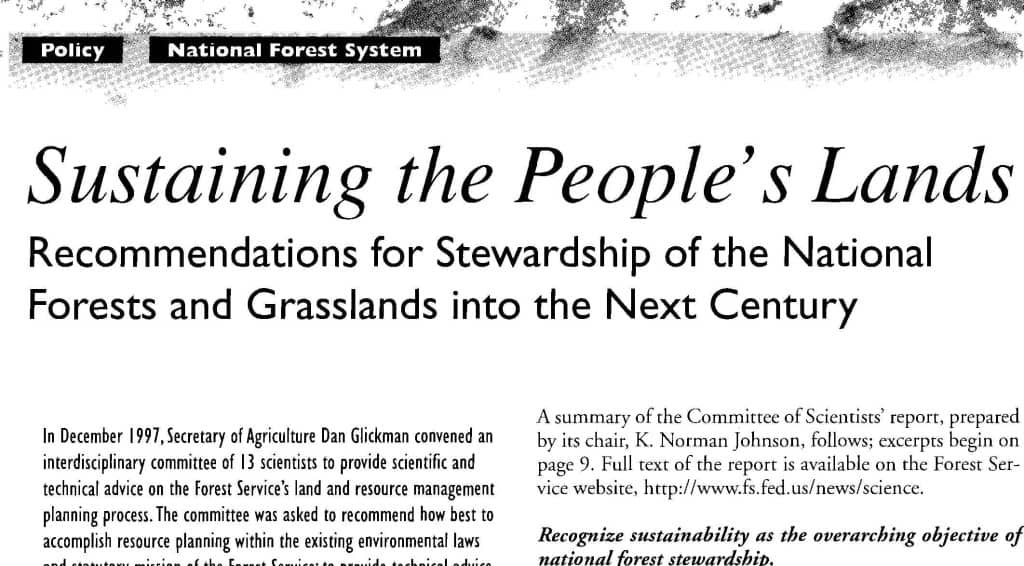Jon and I were having one of our arcane NFMA discussions about desired conditions and the loose leaf notebook concept. Our memories were somewhat different (no surprises!). So I went to my computer files and searched on “loose leaf notebook.” What I was surprised to find was the role of the Committee of Scientists in developing those ideas. The Committee of Scientists was a bunch of scientists (and one legal scholar) who were asked to weigh in on how NFMA planning should work. There were other complementary choices- like asking people and practitioners what worked and what didn’t- suggested by me, or involving professional planning experts, but the Forest Service chose not to take that approach. For those of you who weren’t there or who could use a reminder, I found this Journal of Forestry summary in my notes. It’s interesting to reflect on these ideas and how they have or have not been incorporated or worked in practice over the last 20 years. Here’s a link to the entire report.
The Loose-Leaf Notebook
… the land-and resource-management plan should be in the form of a loose-leaf notebook that contains all of the policy directions, strategies, and implementation proposals from decisions that have been made at all levels of the planning process…. It must also contain the monitoring methodologies that will be implemented as well as the evaluation results from monitoring…. Rather than a formal process involving review and comment, these loose-leaf plans are dynamic and evolving, readily reflecting and accommodating the outcomes of adaptive management. Thus, as decisions are revisited and revised in response to changing social understanding, natural and social events,and policy priorities,the loose-leaf notebook immediately reflects those changes. Consequently, any “amendments”made to these plans reflect decisions that have been made aud reviewed elsewhere.
Desired future conditions also came from this effort.. as a “central reference point” for planning. I think the idea was that more people would agree on DFCs than outputs.
One of the authors (Roger Sedjo, an economist) disagreed with the conclusions and wrote this in the Journal of Forestry in an article (his primary concern was that a mission shift was a political call, not a scientific call):
There is much discussion in the report about managing the national forests for the American people,yet it is clear that the American people are highly disillusioned with the managers
of the national forests.To the distress of some of its members, the committee, which held meetings in all parts of the country,found that many of the most outspoken critics of forest planning and agency management were the local communities and local users of the forest.With few exceptions,these groups and individuals felt cheated by the process.They had entered into the planning process in good faith and spent huge amounts of time working through the process,only to find their decisions overruled by appeals, litigation, or administrative decisions.
It might be interesting for people engaged with planning today to take a look back, and see which of these ideas were tried, which worked, and which did not. It’s also interesting to reflect on the implicit role of stasis in ecosystems and how that has changed in the last 25 ish years due to predictions about climate change. Would the goal of “sustainability” change to “resilience?”

An interesting reflection on history, Sharon. The level of debate internally on how to approach planning was/is as intense as the external debate. Consistency in planning was (is?) an expressed desire across the FS agency…and yet, when principles of consistency were attempted through regulation and policy, local resistance (internal and external) was prominent.
The “loose leaf notebook” never had a chance to be used because so much value was invested in how the land management plan came to be in the 1980s. It seemed to me that those 1980s plans set the mold on how future generations would look at plans. It did not matter what contemporary improvement ideas were conceived – they were always measured against what the 1982 planning rule produced (and was still producing).
Finally, I don’t think the Committee of Scientists ever envisioned the white-hot debates that take place during the planning process. Even the recent planning FACA committee struggled with how to overcome the inevitable quagmire of debate associated with the constantly present “wicked problems”.
My disillusionment came to me in the 90s when I realized that planning was not a scientific exercise, but more of a socio-political one. Many natural resource managers are not well suited for the latter, but the politicos are. It would be interesting to see what a “Committee of Politicians” would come up with and compare that to the Scientists’ Report.
“Rather than a formal process involving review and comment, these loose-leaf plans are dynamic and evolving …”
I think that backs up my perception that this idea was dismissive of the role of the public envisioned by NFMA.
I agree with Tony that the 2012 Rule was not written on a blank slate. While the existing plans and planning process couldn’t be ignored, I think the 1995, 2000, 2005 and 2008 attempts at new planning regulations would have been more radical departures in some ways, but the agency eventually retreated to something more familiar (to both the public and themselves).